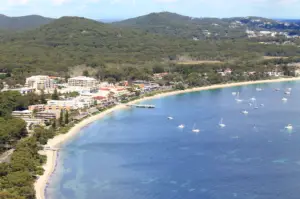THE FIRST CARAVAN PARK
Guudji Yiigu! Welcome to country from the Worimi people at Port Stephens
WORDS BY JANNE HARDY PHOTOGRAPHY BY JANNE AND GEOFF HARDY
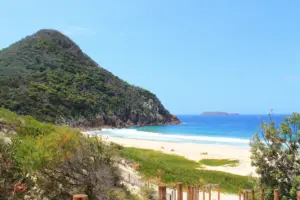
The Port Stephens area is a caravanner’s delight, with truly superb van parks as well as a host of attractions that will have you eager to explore this section of the NSW coast. Just two and a half hours north of Sydney and more than twice as big as Sydney Harbour, Port Stephens is an ideal getaway for city dwellers.
Geoff Wikner, an aircraft engineer, saw its potential as long ago as 1946 – which is when he opened the Halifax Caravan Park, named after the WWII bomber he bought and flew to Australia after the war. Local historians tell us that this was the first caravan park in Australia.
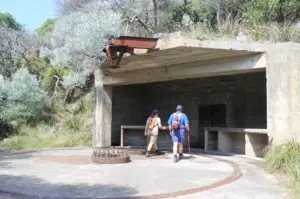
In our opinion this is one of the best-situated parks in Australia. However, you would also enjoy staying in any of the council-owned Beachside Holiday Parks at Shoal Bay, Fingal Bay, Nelson Bay (the Halifax) and further west at Soldiers Point. They all have superb facilities and are in great positions, as well as being reasonably priced and pet friendly.
The Port Stephens area is extensive, covering 1000 square kilometres. The 21-kilometre long drowned valley leaves the hills of Yacaba and Point Stephens joined tenuously by sand to the mainland. Cabbage Tree and Boondalbah Islands sit offshore and the Karuah and Myall Rivers feed in from the west. The result of this, happily for us, is a panorama of sub-tropical beaches and clear blue water for everyone to enjoy. And enjoy it we did!
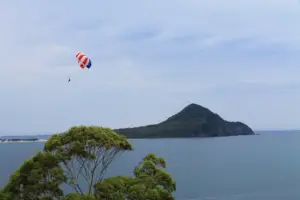
After we had settled into the Halifax Caravan Park we drove out to meet Worimi tour operators, Scotty and Ray, on the shifting Stockton dunes that fringe the area for 32 kilometres to the south. This is the largest shifting dune system in the southern hemisphere.
You’ll find yourself looking up in awe at these sand dunes; they’re up to 30 metres high with a 60-degree slope. That set my heart palpitating, since we were about to ride quad bikes on them, and 30 metres is a long way up. We drove to Murrook where Sand Dune Adventures Quad Bike and Cultural Tours is based. This award winning enterprise is run by the Worimi people who host groups of school children for cultural days as well as running quadbiking and 4WDing tours.
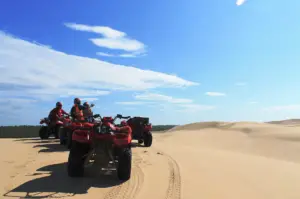
We used exclusive access tracks on reserve land, but before we set out our guides took us carefully through driving procedure on the automatic bikes as well as a thorough safety drill. We had front and rear guides and we followed in the leaders’ tracks as they led us through constantly higher and higher dune country, fringed by fresh water lagoons and dotted with 12,000-year-old middens that have been newly uncovered.
Riders can dictate the level of difficulty but as we had worked on quad bikes we were happy to go where they led – even to the top of a 30m dune with a cornice! Gulp. Off we went into space, with the bright blue surf thundering in the background. It was an amazing experience.
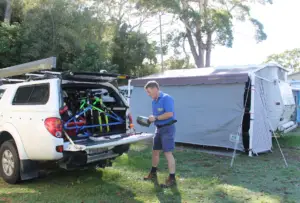
Worimi Conservation Lands are a uniquely co-managed with the National parks and Wildlife Service. Visitors are welcome to enjoy what nature has provided as well as to learn more about the Aboriginal past in the area. Visitor 4WD permits must be obtained to drive on the beach.
Our adventure didn’t end with the quad bikes, though. Later, Port Stephens 4WD picked us up from their parking area at Anna Bay, so we could try sliding down the dunes on our backsides. These guys run a shuttle out to the dunes. They provide you with boards and they can also take you for 4WD bus tours down the beach to visit Tin Town and the Sygna Shipwreck. You can also combine their tours and those of Sand Dune Adventures with cruises aboard the Moonshadow boats from Nelson Bay marina.
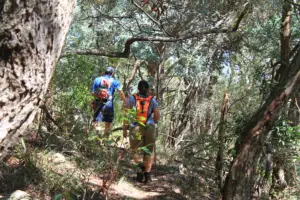
We climbed and slid and wore ourselves out, gratefully retiring to the First Caravan Park to sit on the grass and just stare at the beach. There was beach to the front of us, beach to the back, as well as Nelson Head to the side. It was idyllic.
As we walked around, I saw a sign that said Inner Light Tea Rooms and my first thought was that it was some religious cult that drew people in through a commercial enterprise. I couldn’t have been more wrong, as I discovered when we went to investigate.
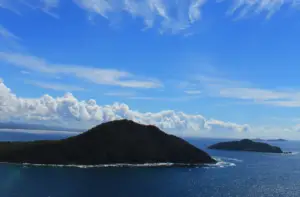
We climbed up the steep Nelson Headland (all hills around Port Stephens are heartbreakers) and at the top we found a green oasis. Nelson Head has held navigation markers for ships from the early 1800s until the construction of a light house here in 1875, but prior to that there were scores of shipwrecks in the area. We found that the lighthouse on Nelson Head was called the Inner Light and there was indeed a tea room with a spectacular view over hills and islands and sea.
Before long it was time for our next adventure. We booked to go to sea on the Hammerhead, a charter fishing boat that we found moored at the Nelson Bay Marina, on a day that promised to be interesting. Our skipper took us out to catch our own bait with handlines and really, that alone almost equalled my best fishing experience ever… but there was better to come.

Lunch was delightful, and then I watched while some of our fellow guests nobly surrendered part of that lunch to create a berley trail. The marine life certainly seemed to think that was a good thing, because we caught all manner of enormous fish. All equipment on the boat was top-class, although some guests brought their own rods, and the crew helped us out when necessary. This turned out to be a good thing for me when they prevented a fish from pulling me in! Generally, our hosts made sure we had a ball; their good humour and excellent knowledge ensured a super day out.
The next day, for something different, I picked up a Heritage Walk brochure from the Information Centre in Nelson Bay. In a solid day’s walking I learnt about the fascinating past of this area. The old track to Newcastle is right in town; along with the bridle paths from the convict days. I found this to be fascinating, taking in the sight of old houses, old wharves and saltwater baths, the first well discovered by Surveyor Charles Grimes in 1795, Chinese fishermen’s grave sites in a cemetery known as God’s Acre, Halifax, our First Caravan Park, and a huge number of World War II sites.
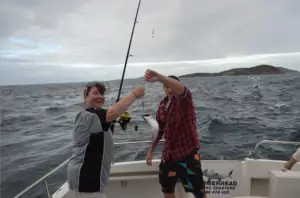
Walking along, you can imagine the escaped convicts that prompted a police presence at Soldiers Point and the smugglers silently slipping from bay to bay to evade troopers determined to stop their illegal trade in grog. You can even see the Aboriginal canoe cuts on the blackbutt trees in town.
Those interested in war history will be interested to find 20,000 Americans and 2,000 Australians trained here between 1942 and 1944. The remains of gun emplacements are dotted around the area and I climbed Tomaree Headland with family and fellow RVers to check them out. A ranger showed us around the gun emplacements so we could see where the men lived, where they stored munitions and the mess, all inside the headland.
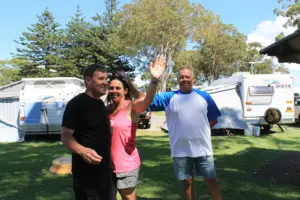
The walk up was very, very steep but the paths and ladders were well built and the view from the top made it all worthwhile. My son Eric and his wife Heidi had brought morning tea for us all to enjoy once we reached the top, which was unexpected and delightful.
From the headland we could see the Moonshadow Dolphin Cruise making its way around the inlet so we decided to go and check it out. Our friend Marion who works in tourism in the area made sure we were on board at the best time of day! A flotilla of bottlenose dolphins gave us a royal escort across the bay to Tea Gardens then around to the headland to Dolphin Rocks. There, a mother and baby dolphins were sheltering in the rocks where boats couldn’t go.
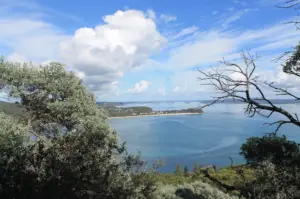
An exciting part of the day was when we got wet in the net off the back of the Moonshadow. This area has the only licensed dolphin swim in NSW so check out your options at the Tourist Info Centre in Nelson Bay.
The dear old ferry sailed into port as we were tying up at the marina. It chugs around the port and for a very reasonable fee you can visit most places of interest aboard this grand old dame of the sea.
From the marina in Nelson Bay a bicycle path follows the shoreline. To your left you’ll have towering hillsides, where beautiful houses perch in tiers, for all the world as though they were in the stands at a footy match. There are 25 beaches in the area and along this walkway they are shaded by dipping trees and towering blackbutts with enormous girths. Make sure you look up because koalas live here, right in town! Then, look down: you might see a little penguin on the beach or a whale sheltering in a cove.
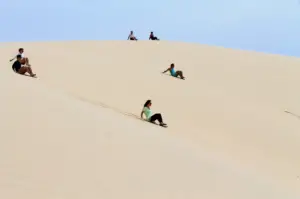
The countryside surrounding Port Stephens provides abundant fresh produce like macadamias, olives, fruit, vegetables, wine and beers. The delightful local markets are on somewhere every weekend.
Since our family had come up from Sydney with their caravans, we all decided to cycle to Fingal Bay where we walked and sat and simply enjoyed each other’s company. Every afternoon we were back with the RV mob, clustered along the grass at Little Beach enjoying a sundowner, watching the thirteen pelicans permanently ensconced at the cleaning tables at the boat ramp. Sometimes we walked along Big Beach to Shoal Bay, picking up whale poo on the sand to send to our granddaughters for show and tell! The place is magical and we were not surprised to find that the First Caravan Park sparked the establishment of many more.
